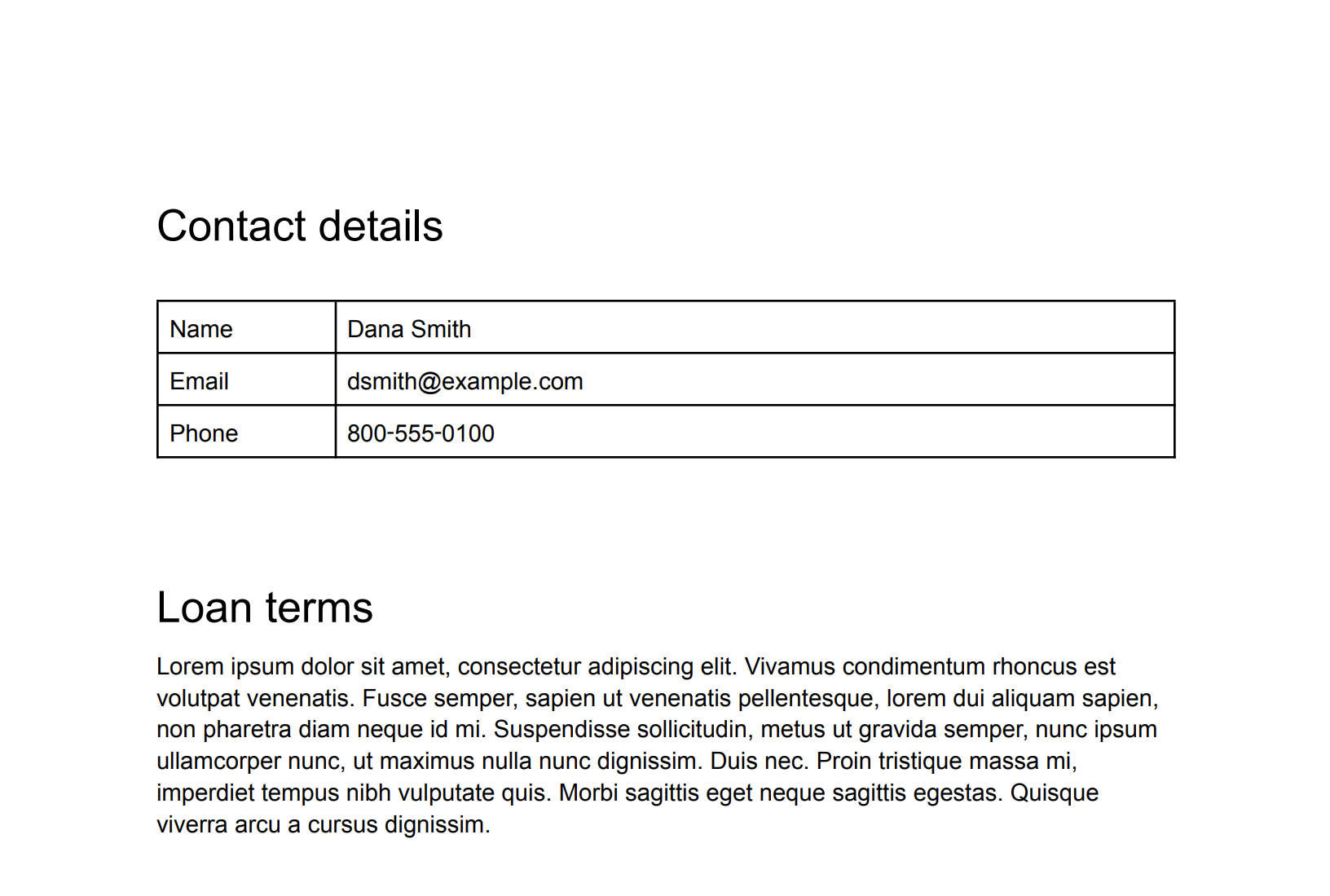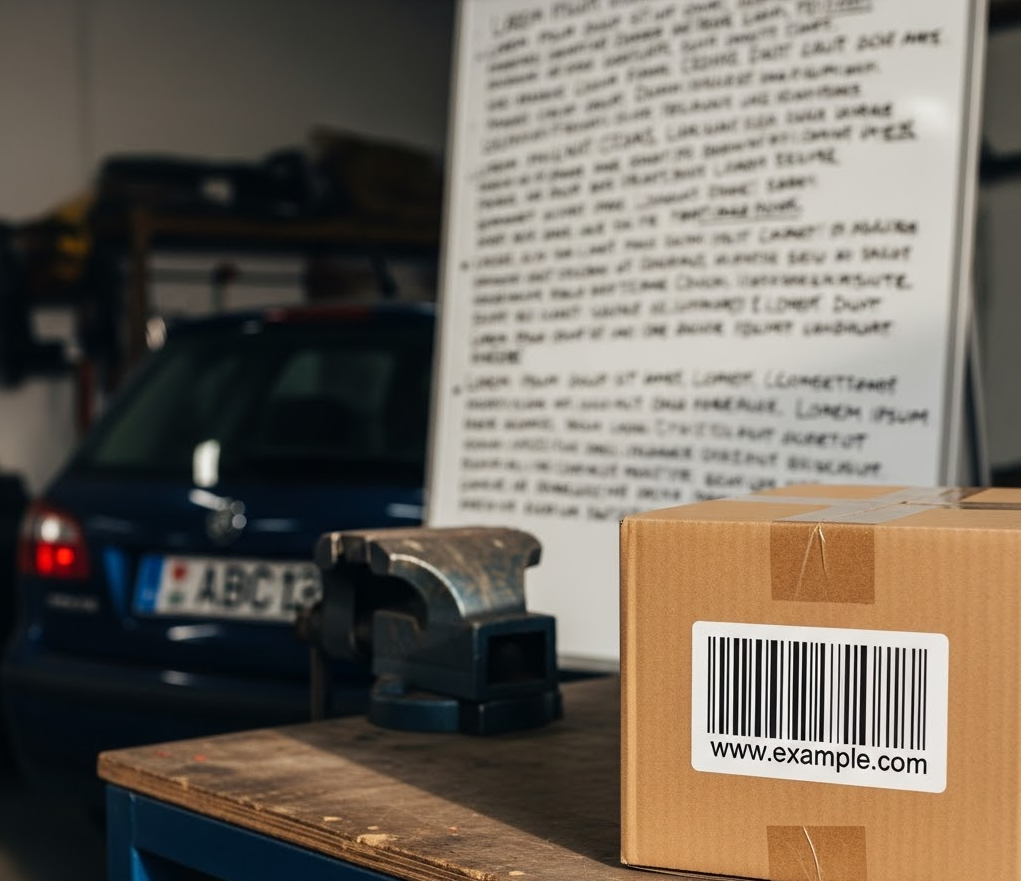Questo documento descrive come utilizzare l'API Cloud Data Loss Prevention per rilevare testo e oggetti sensibili in un'immagine. Sensitive Data Protection restituisce la posizione di tutti i dati sensibili che rileva.
Data un'immagine come input, Sensitive Data Protection rileva i dati sensibili
nell'immagine. L'output di un'operazione di ispezione include gli infoTypes rilevati, la probabilità della corrispondenza e i valori di lunghezza e coordinate dei pixel che indicano le aree in cui Sensitive Data Protection ha trovato i dati sensibili. Le coordinate nell'angolo in basso a sinistra di un'immagine sono (0,0).
Ispeziona un'immagine per tutti gli infoType predefiniti
Per ispezionare un'immagine alla ricerca di dati sensibili, invia un'immagine con codifica base64 al metodo
content.inspect. Se non specifichi tipi di informazioni specifici (infoTypes)
da cercare, Sensitive Data Protection
cerca gli infoType più comuni.
Per esaminare un'immagine per tutti i tipi di informazioni predefiniti:
- Codifica l'immagine in base64.
- Invia una richiesta al metodo
content.inspectdell'API DLP. La richiesta richiede solo l'immagine con codifica base64.
Ad esempio, considera questa immagine di un documento.

C#
Per scoprire come installare e utilizzare la libreria client per Sensitive Data Protection, vedi Librerie client di Sensitive Data Protection.
Per eseguire l'autenticazione in Sensitive Data Protection, configura le Credenziali predefinite dell'applicazione. Per ulteriori informazioni, consulta Configura l'autenticazione per un ambiente di sviluppo locale.
Go
Per scoprire come installare e utilizzare la libreria client per Sensitive Data Protection, vedi Librerie client di Sensitive Data Protection.
Per eseguire l'autenticazione in Sensitive Data Protection, configura le Credenziali predefinite dell'applicazione. Per ulteriori informazioni, consulta Configura l'autenticazione per un ambiente di sviluppo locale.
Java
Per scoprire come installare e utilizzare la libreria client per Sensitive Data Protection, vedi Librerie client di Sensitive Data Protection.
Per eseguire l'autenticazione in Sensitive Data Protection, configura le Credenziali predefinite dell'applicazione. Per ulteriori informazioni, consulta Configura l'autenticazione per un ambiente di sviluppo locale.
Node.js
Per scoprire come installare e utilizzare la libreria client per Sensitive Data Protection, vedi Librerie client di Sensitive Data Protection.
Per eseguire l'autenticazione in Sensitive Data Protection, configura le Credenziali predefinite dell'applicazione. Per ulteriori informazioni, consulta Configura l'autenticazione per un ambiente di sviluppo locale.
PHP
Per scoprire come installare e utilizzare la libreria client per Sensitive Data Protection, vedi Librerie client di Sensitive Data Protection.
Per eseguire l'autenticazione in Sensitive Data Protection, configura le Credenziali predefinite dell'applicazione. Per ulteriori informazioni, consulta Configura l'autenticazione per un ambiente di sviluppo locale.
Python
Per scoprire come installare e utilizzare la libreria client per Sensitive Data Protection, vedi Librerie client di Sensitive Data Protection.
Per eseguire l'autenticazione in Sensitive Data Protection, configura le Credenziali predefinite dell'applicazione. Per ulteriori informazioni, consulta Configura l'autenticazione per un ambiente di sviluppo locale.
REST
Per esaminare questa immagine alla ricerca di infoType predefiniti, invia il seguente JSON al metodo content.inspect:
{ "item": { "byteItem";: { "data": "BASE64_ENCODED_IMAGE", "type": "IMAGE_PNG" } } }
L'output è simile al seguente:
{ "result": { "findings": [ { "infoType": { "name": "PERSON_NAME", "sensitivityScore": { "score": "SENSITIVITY_MODERATE" } }, "likelihood": "LIKELY", "location": { "contentLocations": [ { "imageLocation": { "boundingBoxes": [ { "top": 383, "left": 419, "width": 82, "height": 38 }, { "top": 383, "left": 494, "width": 91, "height": 37 } ] } } ] }, "createTime": "2025-05-22T20:27:03.730Z", "findingId": "2025-05-22T20:27:03.731510Z4997664074931396457" }, { "infoType": { "name": "EMAIL_ADDRESS", "sensitivityScore": { "score": "SENSITIVITY_MODERATE" } }, "likelihood": "VERY_LIKELY", "location": { "contentLocations": [ { "imageLocation": { "boundingBoxes": [ { "top": 445, "left": 390, "width": 357, "height": 48 } ] } } ] }, "createTime": "2025-05-22T20:27:03.728Z", "findingId": "2025-05-22T20:27:03.731538Z284444825812417100" }, { "infoType": { "name": "PHONE_NUMBER", "sensitivityScore": { "score": "SENSITIVITY_MODERATE" } }, "likelihood": "VERY_LIKELY", "location": { "contentLocations": [ { "imageLocation": { "boundingBoxes": [ { "top": 515, "left": 404, "width": 223, "height": 34 } ] } } ] }, "createTime": "2025-05-22T20:27:03.729Z", "findingId": "2025-05-22T20:27:03.731544Z7910624062018243126" }, { "infoType": { "name": "PERSON_NAME", "sensitivityScore": { "score": "SENSITIVITY_MODERATE" } }, "likelihood": "UNLIKELY", "location": { "contentLocations": [ { "imageLocation": { "boundingBoxes": [ { "top": 798, "left": 473, "width": 81, "height": 45 } ] } } ] }, "createTime": "2025-05-22T20:27:03.730Z", "findingId": "2025-05-22T20:27:03.731551Z2345136870450870227" }, { "infoType": { "name": "PERSON_NAME", "sensitivityScore": { "score": "SENSITIVITY_MODERATE" } }, "likelihood": "UNLIKELY", "location": { "contentLocations": [ { "imageLocation": { "boundingBoxes": [ { "top": 837, "left": 1166, "width": 46, "height": 45 } ] } } ] }, "createTime": "2025-05-22T20:27:03.730Z", "findingId": "2025-05-22T20:27:03.731557Z6725780456697828166" }, { "infoType": { "name": "PERSON_NAME", "sensitivityScore": { "score": "SENSITIVITY_MODERATE" } }, "likelihood": "UNLIKELY", "location": { "contentLocations": [ { "imageLocation": { "boundingBoxes": [ { "top": 915, "left": 453, "width": 141, "height": 43 } ] } } ] }, "createTime": "2025-05-22T20:27:03.730Z", "findingId": "2025-05-22T20:27:03.731562Z7328853308213386463" }, { "infoType": { "name": "PERSON_NAME", "sensitivityScore": { "score": "SENSITIVITY_MODERATE" } }, "likelihood": "UNLIKELY", "location": { "contentLocations": [ { "imageLocation": { "boundingBoxes": [ { "top": 915, "left": 1180, "width": 105, "height": 43 } ] } } ] }, "createTime": "2025-05-22T20:27:03.730Z", "findingId": "2025-05-22T20:27:03.731569Z5618332947461439057" } ] } }
In questo esempio, Sensitive Data Protection ha trovato i seguenti infoType, anche se il livello di confidenza della corrispondenza per ciascuno varia:
PERSON_NAMEEMAIL_ADDRESSPHONE_NUMBER
Per ulteriori informazioni sull'utilizzo dell'API DLP con JSON, consulta la guida rapida JSON.
Tieni presente che la protezione dei dati sensibili spesso utilizza più riquadri per indicare dove si trova una singola istanza di dati sensibili nell'immagine.
Ispeziona un'immagine per infoType specifici
Per ispezionare un'immagine solo per determinati tipi di dati sensibili, specifica gli infoType integrati corrispondenti.
Per esaminare un'immagine alla ricerca di tipi di informazioni specifici:
- Codifica l'immagine in base64.
- Invia una richiesta al
metodo
content.inspectdell'API DLP. La richiesta deve includere quanto segue:- L'immagine con codifica base64.
- Uno o più rilevatori di infoType.
C#
Per scoprire come installare e utilizzare la libreria client per Sensitive Data Protection, vedi Librerie client di Sensitive Data Protection.
Per eseguire l'autenticazione in Sensitive Data Protection, configura le Credenziali predefinite dell'applicazione. Per ulteriori informazioni, consulta Configura l'autenticazione per un ambiente di sviluppo locale.
Go
Per scoprire come installare e utilizzare la libreria client per Sensitive Data Protection, vedi Librerie client di Sensitive Data Protection.
Per eseguire l'autenticazione in Sensitive Data Protection, configura le Credenziali predefinite dell'applicazione. Per ulteriori informazioni, consulta Configura l'autenticazione per un ambiente di sviluppo locale.
Java
Per scoprire come installare e utilizzare la libreria client per Sensitive Data Protection, vedi Librerie client di Sensitive Data Protection.
Per eseguire l'autenticazione in Sensitive Data Protection, configura le Credenziali predefinite dell'applicazione. Per ulteriori informazioni, consulta Configura l'autenticazione per un ambiente di sviluppo locale.
Node.js
Per scoprire come installare e utilizzare la libreria client per Sensitive Data Protection, vedi Librerie client di Sensitive Data Protection.
Per eseguire l'autenticazione in Sensitive Data Protection, configura le Credenziali predefinite dell'applicazione. Per ulteriori informazioni, consulta Configura l'autenticazione per un ambiente di sviluppo locale.
PHP
Per scoprire come installare e utilizzare la libreria client per Sensitive Data Protection, vedi Librerie client di Sensitive Data Protection.
Per eseguire l'autenticazione in Sensitive Data Protection, configura le Credenziali predefinite dell'applicazione. Per ulteriori informazioni, consulta Configura l'autenticazione per un ambiente di sviluppo locale.
Python
Per scoprire come installare e utilizzare la libreria client per Sensitive Data Protection, vedi Librerie client di Sensitive Data Protection.
Per eseguire l'autenticazione in Sensitive Data Protection, configura le Credenziali predefinite dell'applicazione. Per ulteriori informazioni, consulta Configura l'autenticazione per un ambiente di sviluppo locale.
REST
Considera l'immagine originale della sezione precedente. Per eseguire l'ispezione solo per indirizzi email e numeri di telefono, invia il seguente JSON al metodo content.inspect.
{ "item": { "byteItem";: { "data": "BASE64_ENCODED_IMAGE", "type": "IMAGE_PNG" } }, "inspectConfig": { "infoTypes": [ { "name": "PHONE_NUMBER" }, { "name": "EMAIL_ADDRESS" } ] } }
L'output è simile al seguente:
{ "result": { "findings": [ { "infoType": { "name": "EMAIL_ADDRESS", "sensitivityScore": { "score": "SENSITIVITY_MODERATE" } }, "likelihood": "VERY_LIKELY", "location": { "contentLocations": [ { "imageLocation": { "boundingBoxes": [ { "top": 445, "left": 390, "width": 357, "height": 48 } ] } } ] }, "createTime": "2025-05-22T20:59:48.653Z", "findingId": "2025-05-22T20:59:48.654873Z3907900286477341146" }, { "infoType": { "name": "PHONE_NUMBER", "sensitivityScore": { "score": "SENSITIVITY_MODERATE" } }, "likelihood": "VERY_LIKELY", "location": { "contentLocations": [ { "imageLocation": { "boundingBoxes": [ { "top": 515, "left": 404, "width": 223, "height": 34 } ] } } ] }, "createTime": "2025-05-22T20:59:48.653Z", "findingId": "2025-05-22T20:59:48.654914Z7486984971818202511" } ] } }
Per ulteriori informazioni sull'utilizzo dell'API DLP con JSON, consulta la guida rapida JSON.
Ispeziona un'immagine per l'individuazione di oggetti sensibili
Per ispezionare un'immagine per l'individuazione di oggetti sensibili, specifica i rilevatori di infoType di oggetti integrati nella richiesta.
Per esaminare un'immagine alla ricerca di infoType di oggetti specifici:
- Codifica l'immagine in base64.
- Invia una richiesta al
metodo
content.inspectdell'API DLP. La richiesta deve includere quanto segue:- L'immagine con codifica base64.
- Uno o più detector infoType oggetto.
Ad esempio, considera l'immagine seguente.

Per esaminare questa immagine alla ricerca di infoType di oggetti specifici, invia il seguente JSON al metodo
content.inspect:
{ "item": { "byteItem";: { "data": "BASE64_ENCODED_IMAGE", "type": "IMAGE_PNG" } }, "inspectConfig": { "infoTypes": [ { "name": "OBJECT_TYPE/BARCODE" }, { "name": "OBJECT_TYPE/LICENSE_PLATE" }, { "name": "OBJECT_TYPE/WHITEBOARD" } ] } }
L'output è simile al seguente:
{ "result": { "findings": [ { "infoType": { "name": "OBJECT_TYPE/WHITEBOARD", "sensitivityScore": { "score": "SENSITIVITY_LOW" } }, "likelihood": "LIKELY", "location": { "contentLocations": [ { "imageLocation": { "boundingBoxes": [ { "left": 427, "width": 561, "height": 678 } ] } } ] }, "createTime": "2025-05-22T22:25:09.564718Z", "findingId": "2025-05-22T22:25:09.564721Z3400818180961962648" }, { "infoType": { "name": "OBJECT_TYPE/LICENSE_PLATE", "sensitivityScore": { "score": "SENSITIVITY_MODERATE" } }, "likelihood": "LIKELY", "location": { "contentLocations": [ { "imageLocation": { "boundingBoxes": [ { "top": 554, "left": 137, "width": 187, "height": 70 } ] } } ] }, "createTime": "2025-05-22T22:25:09.564752Z", "findingId": "2025-05-22T22:25:09.564753Z2359274424382836782" }, { "infoType": { "name": "OBJECT_TYPE/BARCODE", "sensitivityScore": { "score": "SENSITIVITY_LOW" } }, "likelihood": "LIKELY", "location": { "contentLocations": [ { "imageLocation": { "boundingBoxes": [ { "top": 569, "left": 666, "width": 306, "height": 274 } ] } } ] }, "createTime": "2025-05-22T22:25:09.564762Z", "findingId": "2025-05-22T22:25:09.564762Z1655085669963455621" } ] } }
Per ulteriori informazioni sull'utilizzo dell'API DLP con JSON, consulta la guida rapida JSON.
Esempi di codice
Di seguito è riportato codice campione in diverse lingue che mostra come utilizzare Sensitive Data Protection per ispezionare un'immagine alla ricerca di dati sensibili.
C#
Per scoprire come installare e utilizzare la libreria client per Sensitive Data Protection, vedi Librerie client di Sensitive Data Protection.
Per eseguire l'autenticazione in Sensitive Data Protection, configura le Credenziali predefinite dell'applicazione. Per ulteriori informazioni, consulta Configura l'autenticazione per un ambiente di sviluppo locale.
Go
Per scoprire come installare e utilizzare la libreria client per Sensitive Data Protection, vedi Librerie client di Sensitive Data Protection.
Per eseguire l'autenticazione in Sensitive Data Protection, configura le Credenziali predefinite dell'applicazione. Per ulteriori informazioni, consulta Configura l'autenticazione per un ambiente di sviluppo locale.
Java
Per scoprire come installare e utilizzare la libreria client per Sensitive Data Protection, vedi Librerie client di Sensitive Data Protection.
Per eseguire l'autenticazione in Sensitive Data Protection, configura le Credenziali predefinite dell'applicazione. Per ulteriori informazioni, consulta Configura l'autenticazione per un ambiente di sviluppo locale.
Node.js
Per scoprire come installare e utilizzare la libreria client per Sensitive Data Protection, vedi Librerie client di Sensitive Data Protection.
Per eseguire l'autenticazione in Sensitive Data Protection, configura le Credenziali predefinite dell'applicazione. Per ulteriori informazioni, consulta Configura l'autenticazione per un ambiente di sviluppo locale.
PHP
Per scoprire come installare e utilizzare la libreria client per Sensitive Data Protection, vedi Librerie client di Sensitive Data Protection.
Per eseguire l'autenticazione in Sensitive Data Protection, configura le Credenziali predefinite dell'applicazione. Per ulteriori informazioni, consulta Configura l'autenticazione per un ambiente di sviluppo locale.
Python
Per scoprire come installare e utilizzare la libreria client per Sensitive Data Protection, vedi Librerie client di Sensitive Data Protection.
Per eseguire l'autenticazione in Sensitive Data Protection, configura le Credenziali predefinite dell'applicazione. Per ulteriori informazioni, consulta Configura l'autenticazione per un ambiente di sviluppo locale.
Fai una prova
Puoi provare ciascuno di questi esempi o sperimentare con le tue immagini in Explorer API nella pagina di riferimento per content.inspect:
Passaggi successivi
- Scopri di più sull'ispezione e la redazione delle immagini.
- Scopri come oscurare i dati sensibili nelle immagini.

